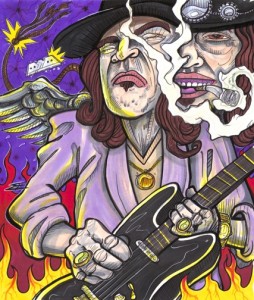Stevie Ray Vaughan was not a rock star in the conventional sense. For one thing, he had tremendous talent, which has become less of a prerequisite for stardom since disco laid waste to rock n’ roll in the 70s. For another, it doesn’t appear that he was a total self-indulgent prick, at least not to the embarrassing degree that the brightest stars reach—or that I do, for that matter. Stevie Ray seems to have been a good guy.
Sure, before he supposedly got sober, Vaughan laced his whiskey with enough cocaine to develop bloody, bubbling holes in his stomach. He also named his band Double Trouble—will we mock him for that for the rest of eternity? He was a Texan, after all, what do you expect? And yes, when his marriage dissolved in his early 30s, Vaughan began keeping company with a nubile 17-year-old model from New Zealand. Some people judged him for his taste for tadpoles, but that just comes with the territory in rock ‘n roll. What about his crone wife, Lenora? “Lenny” snorted up Stevie Ray’s meager record royalties and commenced to gobble cock like a biomorphic turkey/rooster hybrid. Who is the villain of that story, really?
Stevie was a master blues guitar shredder who crashed and burned in his prime on August 27, 1990. He exploded on a fucking ski slope in a helicopter, for Christ’s sake! So I think we should all just give him a break. Yeah, I could fill pages making sport of the guy. I could poke fun at his gummy, Chicklets-jammed-into-Silly-Putty smile or the gayer-than-AIDS scarves he always wore, but really, I’d be a petty asshole to even mention them. So let’s just stick to the music, shall we?
Like his hero Jimi Hendrix, Stevie Ray Vaughan’s prefered ax was a Fender Stratocaster, which he customized to the smallest detail. His favorite was a 1963 model that he and his guitar tech, Rene Martinez, called “Number One” and Stevie Ray called his “First Wife.” “Number One’s sidekick” was a Strat given to him as a gift from his wife, Lenora, which he dubbed “Lenny.” The rest of his small touring ensemble included “Butter,” “Red,” “Charley,” and a just few other cherished guitars. It is arguable that Stevie’s greatest loves were his instruments. Even when the strings broke or the pickups crapped out, they were better behaved than any human could be. Not that Vaughan made his relationship with guitars easy.
Anyone who has picked up a guitar knows that playing even medium gauged strings can feel like you’re doing fingertip push-ups on a bed of nails, but Vaughan played the heaviest gauges. Rene Martinez says that Vaughan started with a .013 and ended up with a .060. Combined with the incredibly high action on the bridge, Stevie Ray often came off stage looking like he’d just tried to feed a rabid badger by hand. That’s how he got such a snappy tone in his performances. His hands were phenomenally strong, so he still pulled off smooth bends that would have the Devil toting his fiddle to a Georgia pawn shop.
Stevie Ray’s gritty blues belongs in a bar, not on a page or computer screen, but here we are. His gravelly voice cried out to the Texas stars, “Gimme a drink, gimme a good woman, and if you fuck with either of them, gimme a fight then, you bad mambajamba!” You, dear reader, shouldn’t be reading morbid blogs your so-called “smart” phone right now, says Stevie—you should be making your way to the nearest honkytonk and dominating the jukebox with SRV tunes, even if that means scrapping the local hip hop fans for the right to get redneck. But if that’s not in the cards and you prefer to YouTube your way to rock n’ roll in total isolation, ol’ JoeBot be right here with you.
It is so difficult to describe a song in words. That’s why the most boring segments of otherwise great books—like Steppenwolf or The Electric Kool-Aid Acid Test—are when the author tries to use words to describe music. If Hesse and Wolfe couldn’t really render a song in literature, it would be foolish for me to attempt it.
I only know Stevie Ray’s songs from frequenting bars—usually the ones with dead animal heads on the wall and no hint of any awareness of import beers. I never knew the man, and I barely know anything about his story. But I do know a roadie who claims that he was working at the Alpine Valley Music Theater the night that Stevie Ray Vaughan’s helicopter whirled through the fog and smashed him into a billion tears.
My roadie friend is a sociopathically loquacious, yet oftentimes charming man with whom I have exchanged many fascinating anecdotes in the dark shadows of the steel. He is an AWOL Army vet who took up cage fighting and sky-diving in his late 40s to offset the depressing deterioration brought on by his chemotherapy—a true fighter. He says that he has relics from Stevie Ray Vaughan’s last show, but is currently collecting clothes and food for the Northeasterners who have just been slammed by Hurricane Irene. When I finally catch up with him, I’ll have photographs for you to marvel over.
Until then, enough with the words. We’ll let this eternally influential guitarist speak for himself from beyond the grave…
© 2011 Joseph Allen
Stevie Ray Vaughan – “Life Without You“
